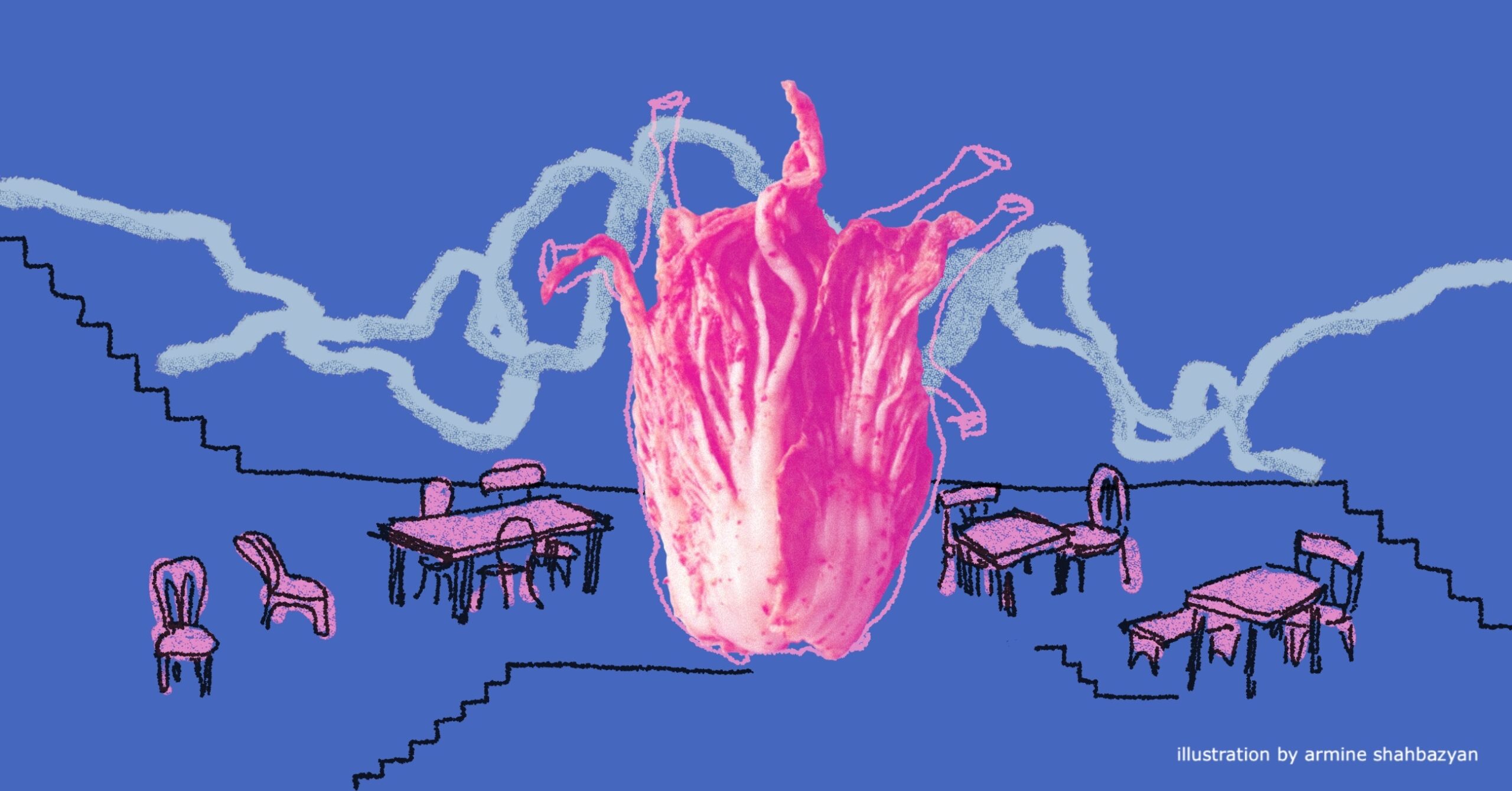
Listen to the article.
In the courtyards around and above Saryan Street in Yerevan, Soviet-era garages have found new purpose as entrepreneurial and creative spaces. One such garage houses the family-run café Hummus Kimchi, which opened in early 2022. Since then, it has become more than just another dining spot—it embodies the capital’s evolving identity of unexpected combinations, fresh ideas and creative repurposing of (post)Soviet architectural heritage.
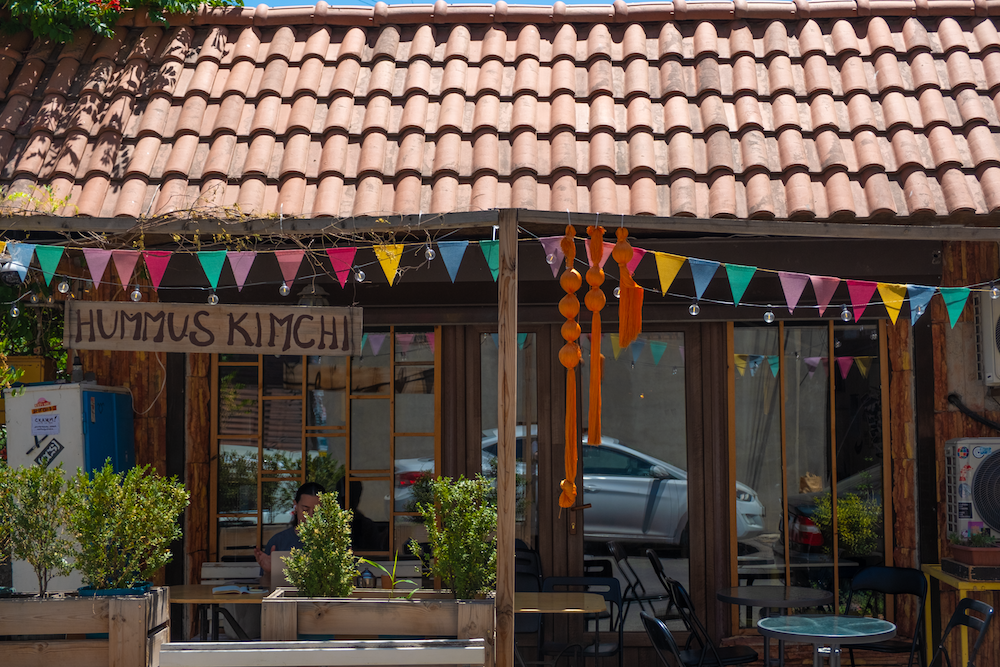
A Family Endeavor
Hummus Kimchi emerged from the unique composition of its founding family: a sister and brother of Jewish origin, along with their spouses—one Armenian and the other partly Korean. Sasha, one of the owners, approaches this multicultural foundation with characteristic humor: “A café that specializes in Korean and Jewish cuisine in Yerevan is sort of a mix of the four of us, a way to pay homage to our diverse origins.”
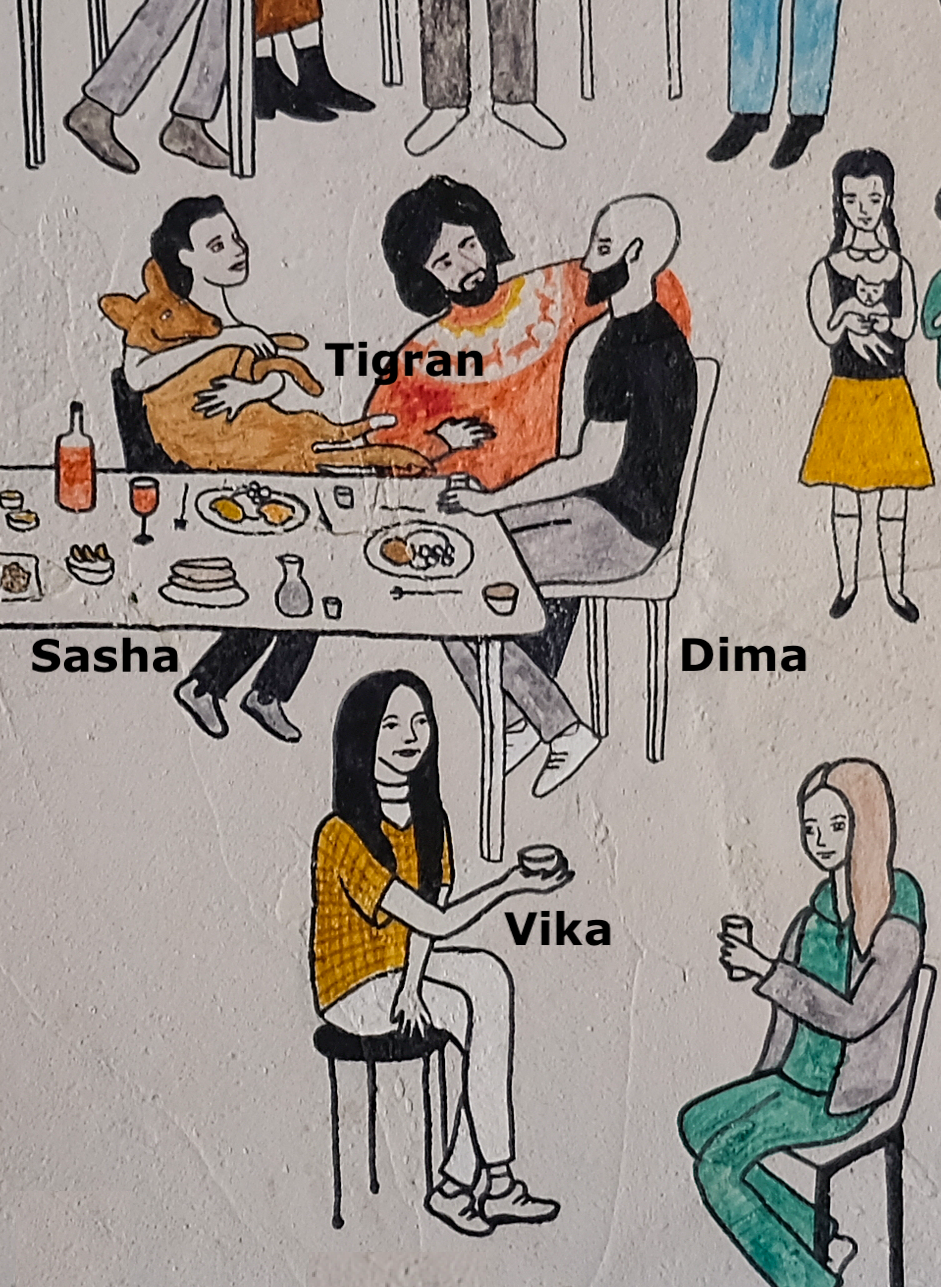
Section from a mural at Hummus Kimchi.
During our interview at a table outside the café, it became clear this was not merely a clever marketing move but a genuine attempt to create something meaningful from their multiethnic heritage. The family’s background provided both the inspiration and practical knowledge needed for their (ad)venture. Sasha’s brother Dima studied Jewish cuisine, complemented by the culinary traditions from his wife’s background. While the inclusion of hummus, often claimed as a staple of both Jewish and Arab cuisines, can be politically charged, here it is treated not as a claim of ownership but as part of a personal and diasporic culinary journey. True to its name, Hummus Kimchi serves dishes from both cuisines, sometimes combining and creatively adapting traditional recipes. The menu is compact, but perfectly executed—their bulgogi with pickled radish or Korean eggplants are absolutely exceptional (as the reader can see, I lean toward the Korean side of the menu).
The decision to establish a business in Yerevan rather than Moscow, where Sasha and her husband Tigran had spent significant time, was driven by practical considerations of cost-efficiency. When the decision about Yerevan solidified, the owners had a clear philosophy about their café’s location and atmosphere.
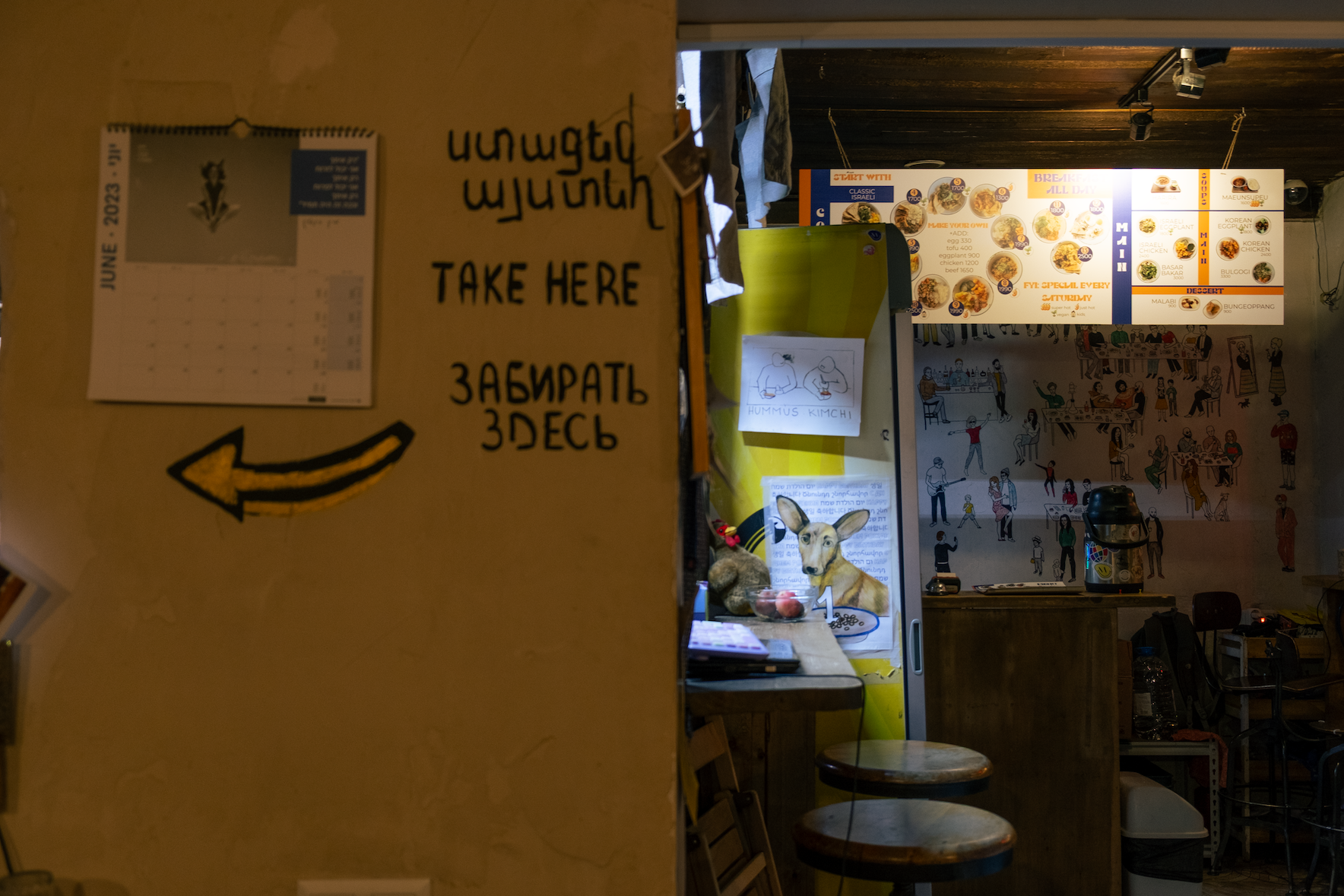
“We never wanted to occupy a prime spot on busy streets like Saryan or Pushkin,” Sasha explains. “Our café is all about family. It embodies a spirit of both public and private space. We sought a slightly hidden venue so that people would come specifically for us, not just because they happened to pass by. Though, of course, all are welcome. Above all, we want people who come to feel at home.”
A garage is a perfect location for such a vision, occupying a unique position among built forms. It serves as another storage room of the household, yet in the (post)Soviet context, it exists outside the house itself.
Challenging Cultural Norms
The space that now houses Hummus Kimchi comes with a mysterious history that adds to its appeal. The garage was first repurposed as a fish shop, then grocery store, and later, a bakery with its own tandoor (still visible in the Hummus Kimchi kitchen). It subsequently served as a meeting spot for the Sasna Tsrer party. As Sasha noted, “It was a very weird place when we found it.” In keeping with the spirit of this weird place, Hummus Kimchi challenged established social expectations in Yerevan’s dining culture:
“The mix of cuisines, the garage, the big table in a café in Yerevan…” Sasha says. “As far as I understood it from what my husband’s family and friends told me, Armenians would not usually sit at a communal table alongside strangers.”
This large communal table was a statement about how people might relate to each other in urban spaces, stretching established patterns where such seating was reserved for family gatherings. The garage setting further pushed these customary social norms, creating what philosophers like Martin Heidegger would recognize as a space where meaning emerges through lived experience rather than predetermined design.

Despite initial skepticism, Hummus Kimchi found its patrons and began to thrive. The success led to the opening of the Spot bar in the yard below the garage. More importantly, the café began to shift cultural perceptions and social practices: “While most clients of Hummus Kimchi were initially non-Armenian, this ratio has changed. We’re happy to see this integration into the local Yerevani community. Though part of the family are migrants ourselves, it brings us such joy to see more local residents discover our place.”
Built Heritage and Innovation
The transformation of Soviet-era garages in Yerevan represents a significant aspect of contemporary urban development, emphasizing freedom and cultural expression. During Soviet times, when property rights were limited, garages became sites where people negotiated concepts of ownership and civic self-organization through cooperatives, learning what it truly means to be citizens. After the collapse of state socialism, Yerevan’s residents began reimagining and repurposing these garages. Their grassroots efforts involved building within existing structures, spatial expansion, and adding new functions—all made possible by the seemingly suspended regulatory frameworks. The multiple previous lives of the Hummus Kimchi garage reflect a broader pattern in post-Soviet cities, where garages have evolved from car washes and workshops into fashion boutiques, offices, cafés, and art galleries.
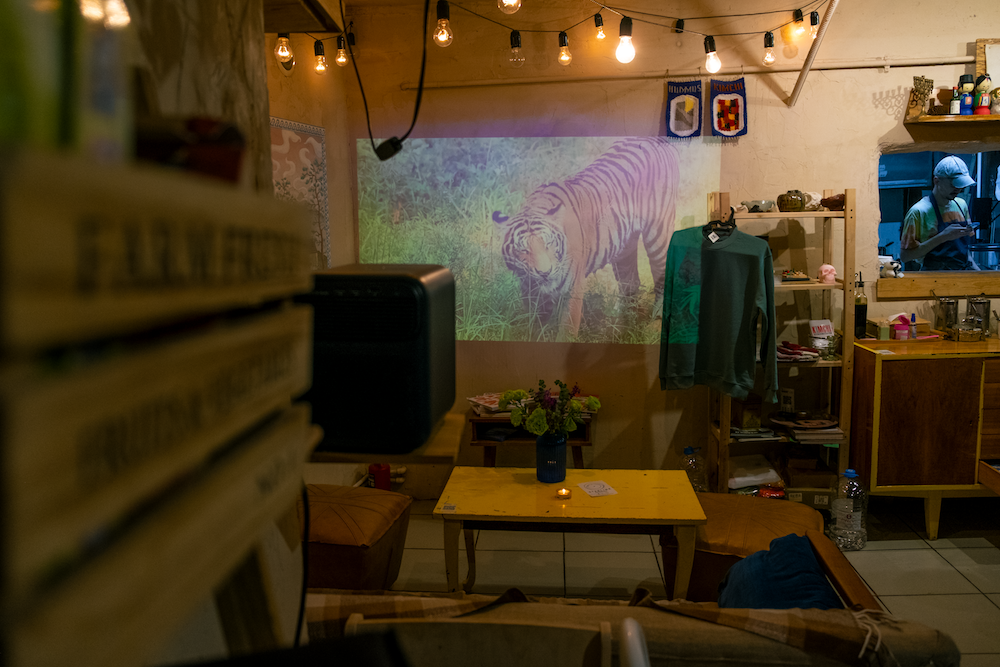
Though once dismissed as mundane by urban scholars, the garage has emerged as one of the 20th century’s most adaptable architectural forms. In their book on garages, artists Olivia Erlanger and Luis Ortega Govela describe garages as Duchampian Readymades, everyday objects that, through recontextualization, transform into something entirely new. Just as Walter Benjamin used the arcade to understand urban modernity, the garage helps us understand contemporary entrepreneurship and radical individualism of the post-modern era.
Hummus Kimchi’s success represents more than entrepreneurship––it exemplifies adaptation and design innovation. Like the 13.20 ruin bar I wrote about in SALT’s May issue, it demonstrates how marginalized spaces and “insignificant” structures can become centers of cultural production and social interaction, silently opposing the traditional hierarchies of the built forms. It’s no surprise then, that the team behind the Library for Architecture had chosen the garage as the theme for Armenia’s pavilion at the 2025 Triennale Milano.
Epilogue
As Yerevan continues to evolve, spaces like Hummus Kimchi point toward new possibilities for urban development, ones that prioritize adaptive reuse and dialogue over demolition, displacement and replacement. The café’s success demonstrates both demand and opportunity for ventures that bridge cultural differences while respecting local contexts. By working within existing structures, initiatives like Hummus Kimchi prove that renovation can be both economically viable and sensitive to the surroundings.
Within the constraints and opportunities of the post-Soviet cityscape, Hummus Kimchi shows that sometimes profound transformations happen in the most unexpected places, even behind the humble doors of a simple garage. It suggests that the future of cities lies not (and perhaps should not) in grand architectural gestures and starchitect spectacles, but in the thoughtful cultivation of micropublic spaces that foster diversity, community, and new forms of belonging in an ever-changing fragile world.
Photographs by Lilith Margaryan.
Under the Open Sky
The June issue of SALT explores how tradition and reinvention meet across culture, style and taste. We look at the growing comeback of film photography through the lens of Yerevan’s photo labs, feature a visual story of open-air ballet performances in Tumanyan Park, visit Hummus Kimchi, a restaurant blending Jewish and Korean cuisines, and talk to Syrian- and Lebanese-Armenian hairdressers who are raising the bar in Yerevan’s beauty scene. Plus, a photo essay captures the energy and atmosphere of Yerevan Wine Days.
Toes, Tutus and Twilight: Yerevan’s Ballet Fest
Yerevan Ballet Fest returned to Tumanyan Park, transforming the heart of the city into an open-air stage. With performances by the Bolshoi, Mariinsky, and local companies, the week-long festival brought world-class ballet to thousands under the summer sky.
Read moreFragile in Nature, Strong in Form: Analog Photography in Yerevan
Amid a digital age, film photography finds new life in Yerevan. This personal journey through snowy streets, underground labs, and passionate communities reveals how analog photography reemerged through creativity, limitation and human connection.
Read more



